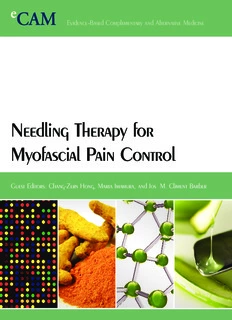
Needling Therapy for Myofascial Pain Control PDF
Preview Needling Therapy for Myofascial Pain Control
Evidence-Based Complementary and Alternative Medicine Needling Therapy for Myofascial Pain Control Guest Editors: Chang-Zern Hong, Marta Imamura, and José M. Climent Barberá Needling Therapy for Myofascial Pain Control Evidence-Based Complementary and Alternative Medicine Needling Therapy for Myofascial Pain Control Guest Editors: Chang-Zern Hong, Marta Imamura, and Jose´ M. Climent Barbera´ Copyright©2013HindawiPublishingCorporation.Allrightsreserved. Thisisaspecialissuepublishedin“Evidence-BasedComplementaryandAlternativeMedicine.”Allarticlesareopenaccessarticles distributedundertheCreativeCommonsAttributionLicense,whichpermitsunrestricteduse,distribution,andreproductioninany medium,providedtheoriginalworkisproperlycited. Editorial Board TerjeAlraek,Norway PeterFisher,UK Ire´neLund,Sweden ShrikantAnant,USA RomainForestier,France GailB.Mahady,USA SedighehAsgary,Iran JoelJ.Gagnier,Canada SubhashC.Mandal,India HyunsuBae,RepublicofKorea MuhammadN.Ghayur,Pakistan J.L.Marnewick,SouthAfrica LijunBai,China AnwarulH.Gilani,Pakistan FrancescoMarotta,Italy SarangBani,India MichaelGoldstein,USA VirginiaS.Martino,Argentina VassyaBankova,Bulgaria SveinHaavik,Norway JamesH.McAuley,Australia WinfriedBanzer,Germany Seung-HeonHong,Korea AndreasMichalsen,Germany VernonA.Barnes,USA MarkusHorneber,Germany DavidMischoulon,USA JairoKenuppBastos,Brazil Ching-LiangHsieh,Taiwan Hyung-InMoon,RepublicofKorea SujitBasu,USA BennyT.K.Huat,Singapore AlbertMoraska,USA DavidBaxter,NewZealand RomanHuber,Germany MarkMoss,UK Andre-MichaelBeer,Germany AngeloA.Izzo,Italy MinKyunNa,RepublicofKorea AlvinJ.Beitz,USA K.Jarukamjorn,Thailand RichardL.Nahin,USA PaoloBellavite,Italy StefanieJoos,Germany VitalyNapadow,USA YongC.Boo,RepublicofKorea Z.Kain,USA F.R.F.Nascimento,Brazil FrancescaBorrelli,Italy OsamuKanauchi,Japan IsabellaNeri,Italy GloriaBrusotti,Italy KrishnaKaphle,Nepal T.B.Nguelefack,Cameroon ArndtBu¨ssing,Germany KenjiKawakita,Japan MartinOffenbacher,Germany LeighF.Callahan,USA JongY.Kim,RepublicofKorea Ki-WanOh,RepublicofKorea RaffaeleCapasso,Italy Cheorl-HoKim,RepublicofKorea Y.Ohta,Japan OpherCaspi,Israel YounC.Kim,RepublicofKorea OlumayokunA.Olajide,UK Shun-WanChan,HongKong YoshiyukiKimura,Japan ThomasOstermann,Germany Il-MooChang,RepublicofKorea ToshiakiKogure,Japan StaceyA.Page,Canada RajnishChaturvedi,India ChingLan,Taiwan Tai-LongPan,Taiwan Tzeng-JiChen,Taiwan AlfredLa¨ngler,Germany BhushanPatwardhan,India YunfeiChen,China LixingLao,USA BeritSmestadPaulsen,Norway KevinChen,USA Jang-HernLee,RepublicofKorea AndreaPieroni,Italy Juei-TangCheng,Taiwan Tatl.Lee,Singapore RichardPietras,USA EvanP.Cherniack,USA MyeongS.Lee,UK XianqinQu,Australia Jen-HweyChiu,Taiwan ChristianLehmann,Canada CassandraL.Quave,USA WilliamCho,HongKong MarcoLeonti,Italy RojaRahimi,Iran JaeYoulCho,Korea Ping-ChungLeung,HongKong KhalidRahman,UK Shuang-EnChuang,Taiwan ChunGuangLi,Australia CheppailRamachandran,USA EdwinL.Cooper,USA Xiu-MinLi,USA KeRen,USA VincenzoDeFeo,Italy ShaoLi,China Mee-RaRhyu,RepublicofKorea Roc´ıoDelaPuertaVa´zquez,Spain SabinaLim,Korea Jose´LuisR´ıos,Spain AlexandraDeters,Germany WenChuanLin,China PaoloR.diSarsina,Italy DrissaDiallo,Norway ChristopherG.Lis,USA BasharSaad,PalestinianAuthority MohamedEddouks,Morocco GerhardLitscher,Austria A.Sandner-Kiesling,Austria AmrE.Edris,Egypt I-MinLiu,Taiwan AdairSantos,Brazil TobiasEsch,Germany KeLiu,China G.Schmeda-Hirschmann,Chile YibinFeng,HongKong YijunLiu,USA RosaSchnyer,USA JosueFernandez-Carnero,Spain GaofengLiu,China AndrewScholey,Australia JulianoFerreira,Brazil CynthiaR.Long,USA VeroniqueSeidel,UK DanaSeidlova-Wuttke,Germany K.V.Trinh,Canada KenjiWatanabe,Japan SenthamilR.Selvan,USA VolkanTugcu,Turkey W.Weidenhammer,Germany TuhinadriSen,India Yew-MinTzeng,Taiwan JennyM.Wilkinson,Australia RonaldSherman,USA CatherineUlbricht,USA HarukiYamada,Japan KarenJ.Sherman,USA DawnM.Upchurch,USA NobuoYamaguchi,Japan KanShimpo,Japan AlfredoVannacci,Italy HitoshiYamashita,Japan Byung-CheulShin,Korea ManiVasudevan,Malaysia YongQingYang,China Jian-nanSong,China JosephR.Vedasiromoni,India KenYasukawa,Japan RachidSoulimani,France CarloVentura,Italy E.Yesilada,Turkey MohdR.Sulaiman,Malaysia WagnerVilegas,Brazil M.Yoon,RepublicofKorea VenilN.Sumantran,India PradeepVisen,Canada HongQ.Zhang,HongKong TokuTakahashi,USA AristoVojdani,USA RuixinZhang,USA TakashiTakahashi,Japan DietlindWahner-Roedler,USA BoliZhang,China RabihTalhouk,Lebanon Chong-ZhiWang,USA HongZhang,Sweden ChunTaoChe,USA Shu-MingWang,USA HaiboZhu,China MeiTian,China ChenchenWang,USA YaoTong,HongKong Y.Wang,USA Contents NeedlingTherapyforMyofascialPainControl,Chang-ZernHong,MartaImamura, andJose´M.ClimentBarbera´ Volume2013,ArticleID946597,2pages ComparisonsofPredictionModelsofMyofascialPainControlafterDryNeedling:AProspectiveStudy, Yuan-TingHuang,Choo-AunNeoh,Shun-YuanLin,andHon-YiShi Volume2013,ArticleID478202,8pages RemoteEffectofLowerLimbAcupunctureonLatentMyofascialTriggerPointofUpperTrapezius Muscle:APilotStudy,Kai-HuaChen,Kuang-YuHsiao,Chu-HsuLin,Wen-MingChang,Hung-ChihHsu, andWei-ChiHsieh Volume2013,ArticleID287184,8pages NeuromuscularDamageandRepairafterDryNeedlinginMice,AresDomingo,OrlandoMayoral, SoniaMonterde,andManelM.Santafe´ Volume2013,ArticleID260806,10pages EfficacyofMyofascialTriggerPointDryNeedlinginthePreventionofPainafterTotalKnee Arthroplasty:ARandomized,Double-Blinded,Placebo-ControlledTrial,OrlandoMayoral, IsabelSalvat,Mar´ıaTeresaMart´ın,StellaMart´ın,Jesu´sSantiago,Jose´Cotarelo,andConstantinoRodr´ıguez Volume2013,ArticleID694941,8pages BotulinumToxinfortheTreatmentofMyofascialPainSyndromesInvolvingtheNeckandBack: AReviewfromaClinicalPerspective,Jose´M.Climent,Ta-ShenKuan,PedroFenollosa, andFranciscoMartin-del-Rosario Volume2013,ArticleID381459,10pages ProbableMechanismsofNeedlingTherapiesforMyofascialPainControl,Li-WeiChou,Mu-JungKao, andJaung-GengLin Volume2012,ArticleID705327,11pages RemoteSubcutaneousNeedlingtoSuppresstheIrritabilityofMyofascialTriggerSpots:An ExperimentalStudyinRabbits,ZhonghuaFu,Yueh-LingHsieh,Chang-ZernHong,Mu-JungKao, Jaung-GengLin,andLi-WeiChou Volume2012,ArticleID353916,8pages DryNeedlingatMyofascialTriggerSpotsofRabbitSkeletalMusclesModulatestheBiochemicals AssociatedwithPain,Inflammation,andHypoxia,Yueh-LingHsieh,Shun-AnYang,Chen-ChiaYang, andLi-WeiChou Volume2012,ArticleID342165,12pages PercutaneousSoftTissueReleaseforTreatingChronicRecurrentMyofascialPainAssociatedwith LateralEpicondylitis:6CaseStudies,Ming-TaLin,Li-WeiChou,Hsin-ShuiChen,andMu-JungKao Volume2012,ArticleID142941,7pages HindawiPublishingCorporation Evidence-BasedComplementaryandAlternativeMedicine Volume2013,ArticleID946597,2pages http://dx.doi.org/10.1155/2013/946597 Editorial Needling Therapy for Myofascial Pain Control Chang-ZernHong1,2 1DepartmentofPhysicalTherapy,HungkuangUniversity,Sha-Lu,Tai-Chung433,Taiwan 2DepartmentofPhysicalMedicineandRehabilitation,UniversityofCaliforniaIrvine,Irvine,CA92818,USA CorrespondenceshouldbeaddressedtoChang-ZernHong;[email protected] Received25July2013;Accepted25July2013 Copyright©2013Chang-ZernHong.ThisisanopenaccessarticledistributedundertheCreativeCommonsAttributionLicense, whichpermitsunrestricteduse,distribution,andreproductioninanymedium,providedtheoriginalworkisproperlycited. Needling therapy has been widely used for pain control. bicepsfemorismusclescouldmodulatevariousbiochemicals “Needling”includesallprocedureswithpenetrationofanee- associated with pain, inflammation,and hypoxia in a dose- dlethroughtheskinwithinjectionofmedication(injection dependentmanner.TheotheranimalstudybyA.Domingo therapy)orwithoutintroductionofanydrug(dryneedling). etal.foundthatrepeateddryneedlingpuncturesinmuscle Ineitherinjectionordryneedling,thesiteoftreatmentcan do not perturb the different stages of muscle regeneration beatthesiteofpain(directneedling)orfarfromthesiteof andreinnervation.AnotherresearchstudybyM.-T.Linetal. pain(remoteneedling).Needlingtherapyincludestraditional suggestedthattheartificialneuralnetwork(ANN)modelwas acupuncture,needlingwithmultipleinsertions,dryneedling moreaccurateinpredictingpatient-reportedpainscoresand withelectricalstimulation,superficialneedling,andFu’ssub- had higher overall performance indices. Finally two papers cutaneousdryneedling. reported their newly developed techniques for myofascial Myofascial pain is a regional pain syndrome character- pain control. An animal study by Fu et al. further confirm izedwiththeexistenceofasensitivespot(myofascialtrigger theeffectivenessandthepossiblemechanismofFu’sremote point(MTrP))inthetautbandofskeletalmusclefibers.MTrP needlingformyofascialpantherapy.ThestudybyLinetal. can be inactivated by appropriate treatment with physical demonstratedtheeffectivenessofLin’spercutaneoussofttis- therapy(includingmanualtherapy)orneedlingtherapy. suerelease(lessinvasivethanthesurgicalrelease)fortreating Thisspecialissuecontainsninepapers,ofwhichtwoare chronicrecurrentmyofascialpainduetolateralepicondylitis. review articles and seven are research articles. The review Many studies in this issue reported the application of paperbyL.-W.Chouetal.discussedvariousproposedmech- multiple insertion technique for dry needling therapy. In anisms published previously and concluded that multiple either clinical practice or research studies, it has been sug- mechanisms are probably involved in needling analgesia. gestedthatneedlingwith“multipleinsertiontechnique”can Another review paper by J. M. Climent et al. discussed the usuallyprovidethebestandfastesteffectsforimmediatepain clinicaltrialsofbotulinumtoxininjectionfortreatingmyo- control. This technique was originally described by Travell fascial pain in the neck and back, and concluded that bot- and Bobb for myofascial trigger point (MTrP) injection. ulinum toxin could be useful in specific myofascial pain Duringinjection,theneedlewasmovedinandoutintodif- regions, especially for patients with refractory myofascial ferent directions to elicit painful sensation (to encounter pain that has not responded to other myofascial injection the sensitive loci) in an MTrP region. In this way, MTrP therapies.Twoclinicalstudiesdemonstratedtheeffectiveness paincanusuallybeeliminatednearlycompletelyimmediately of dry needling in treating myofascial pain after total knee aftermostofthosemultiplesensitivelocihavebeeninjected arthroplasty(O.Mayoraletal.)andremotepainintheupper (orencountered).Consideringthetimeconsumingandthe trapezius muscle (K.-H. Chen et al.). One animal study by possibility of muscle fiber damage during this slow needle Y.-L.Hsiehetal.showedthatdryneedlingatthemyofascial movement, C.-Z. Hong has modified this technique into a trigger spots (MTrSs, equivalent to human MTrP) of rabbit “fast-movementprocedure”inordertoavoidtissuedamage 2 Evidence-BasedComplementaryandAlternativeMedicine fromsidemovementofneedleorgrabofneedlebytheelicited localtwitchresponses(LTRs).Later,thisnewtechniquehas beenrecommendedbySimonsandhasbeenwidelyusedfor MTrPinjectionordryneedling. The descending pain inhibitory system is probably involved in the mechanism of immediate pain relief after multipleneedleinsertion.Eitherhyperstimulationanalgesia for general pain control or disruption of “MTrP” circuit for myofascial pain control is actually via the descend- ing inhibitory system. It has been suggested that eliciting LTRs(feelingsimilarto“De-Qui”effect)duringneedlingis essential to obtain an immediate and complete pain relief after MTrP needling or MTrP injection. Eliciting an LTR or obtaining “De-Qi” effect indicates that a sensitive locus (sensitized nociceptor) is encountered by the needle tip. It appears that, when a sensitive locus is encountered by the tinyneedletip,“De-Qi”effectcanbeperceivedandanLTR canbeelicited,andthentheirritabilityofthissensitivelocus canbesuppressedimmediately.NeedlingofakeyMTrPcan also inhibit the irritability of satellite MTrPs due to central desensitization phenomenon. It is important to provide strong stimuli to the sensitive loci as many as possible to obtain optimal hyperstimulation in order to have maximal pain relief; so that the “multiple insertion technique” can providebettereffectsthanjustasinglesitestimulation. Basedonthereportsinthisspecialissue,itisverylikely thattheaboveissueshavebeenfurtherclarified. Chang-ZernHong HindawiPublishingCorporation Evidence-BasedComplementaryandAlternativeMedicine Volume2013,ArticleID478202,8pages http://dx.doi.org/10.1155/2013/478202 Research Article Comparisons of Prediction Models of Myofascial Pain Control after Dry Needling: A Prospective Study Yuan-TingHuang,1Choo-AunNeoh,2 Shun-YuanLin,2andHon-YiShi3 1NursingDepartment,KaohsiungArmedForcesGeneralHospital,Kaohsiung80201,Taiwan 2SectionofAnesthesiology,PingtungChristianHospital,Pingtung90059,Taiwan 3DepartmentofHealthcareAdministrationandMedicalInformatics,KaohsiungMedicalUniversity,No.100, Shih-Chuan1stRoad,Kaohsiung80708,Taiwan CorrespondenceshouldbeaddressedtoHon-YiShi;[email protected] Received3December2012;Accepted10June2013 AcademicEditor:Jose´M.ClimentBarbera´ Copyright©2013Yuan-TingHuangetal. This is an open access article distributed under the Creative Commons Attribution License,whichpermitsunrestricteduse,distribution,andreproductioninanymedium,providedtheoriginalworkisproperly cited. Background.Thisstudypurposedtovalidatetheuseofartificialneuralnetwork(ANN)modelsforpredictingmyofascialpain control after dry needling and to compare the predictive capability of ANNs with that of support vector machine (SVM) and multiplelinearregression(MLR).Methods.Totally400patientswhohavereceiveddryneedlingtreatmentscompletedtheBrief PainInventory(BPI)atbaselineandat1yearpostoperatively.Results.ComparedtotheMLRandSVMmodels,theANNmodel generallyhadsmallermeansquareerror(MSE)andmeanabsolutepercentageerror(MAPE)valuesinthetrainingdatasetand testingdataset.MostANNmodelshadMAPEvaluesrangingfrom3.4%to4.6%andmosthadhighpredictionaccuracy.The globalsensitivityanalysisalsoshowedthatpretreatmentBPIscorewasthebestparameterforpredictingpainafterdryneedling. Conclusion.ComparedwiththeMLRandSVMmodels,theANNmodelinthisstudywasmoreaccurateinpredictingpatient- reportedBPIscoresandhadhigheroverallperformanceindices.Furtherstudiesofthismodelmayconsidertheeffectofamore detaileddatabasethatincludescomplicationsandclinicalexaminationfindingsaswellasmoredetailedoutcomedata. 1.Introduction constructing hyperplanes in a multidimensional space that separatescasesofdifferentclasslabels.However,SVMshave Myofascialpainsyndrome(MPS),acommoncauseofmus- also been proven effective for solving regression problems culoskeletal pain presenting in primary care, results from because they can handle multiple continuous variables [6– myofascialtriggerpointactivity[1,2].Dryneedlingisatreat- 10].Artificialneuralnetworks(ANNs)arecomplexandflex- mentmodalitythatisminimallyinvasive,cheap,andeasyto ible nonlinear systems with properties not found in other learnwithappropriatetrainingandcarriesalowrisk.Itseffec- modeling systems. These properties include robust perfor- tivenesshasbeenconfirmedinnumerousstudiesandcom- mance in dealing with noisy or incomplete input patterns, prehensive systematic reviews [3–5]. Accurately predicting highfaulttolerance,andthecapabilitytogeneralizefromthe myofascial pain control, a standard outcome measure after input data [6–10]. The computational power of an ANN is dryneedling,isimportantwhenselectingtreatmentmodality derived from the distributed nature of its connections. The andwhenallocatingscarcemedicalresources[1,2]. ANNmodelisawell-establisheddataminingalgorithmthat Regression analysis, one of the most widely used mul- iswidelyusedinvariousfields,fromengineeringtobiomed- tivariate analysis methods, assumes linear relationships icalscience[6–10]. between independent and dependent variables. However, Themultilayerperceptron(MLP)isthemostfrequently studies show that changes in biomedical variables are often used ANN due to its ability to model nonlinear systems nonlinear [6–10]. The major classifier methods use support andestablishnonlineardecisionboundariesinclassification vectormachines(SVMs)tosolveclassificationproblemsby problemssuchasopticalcharacterrecognition,datamining,
Description: